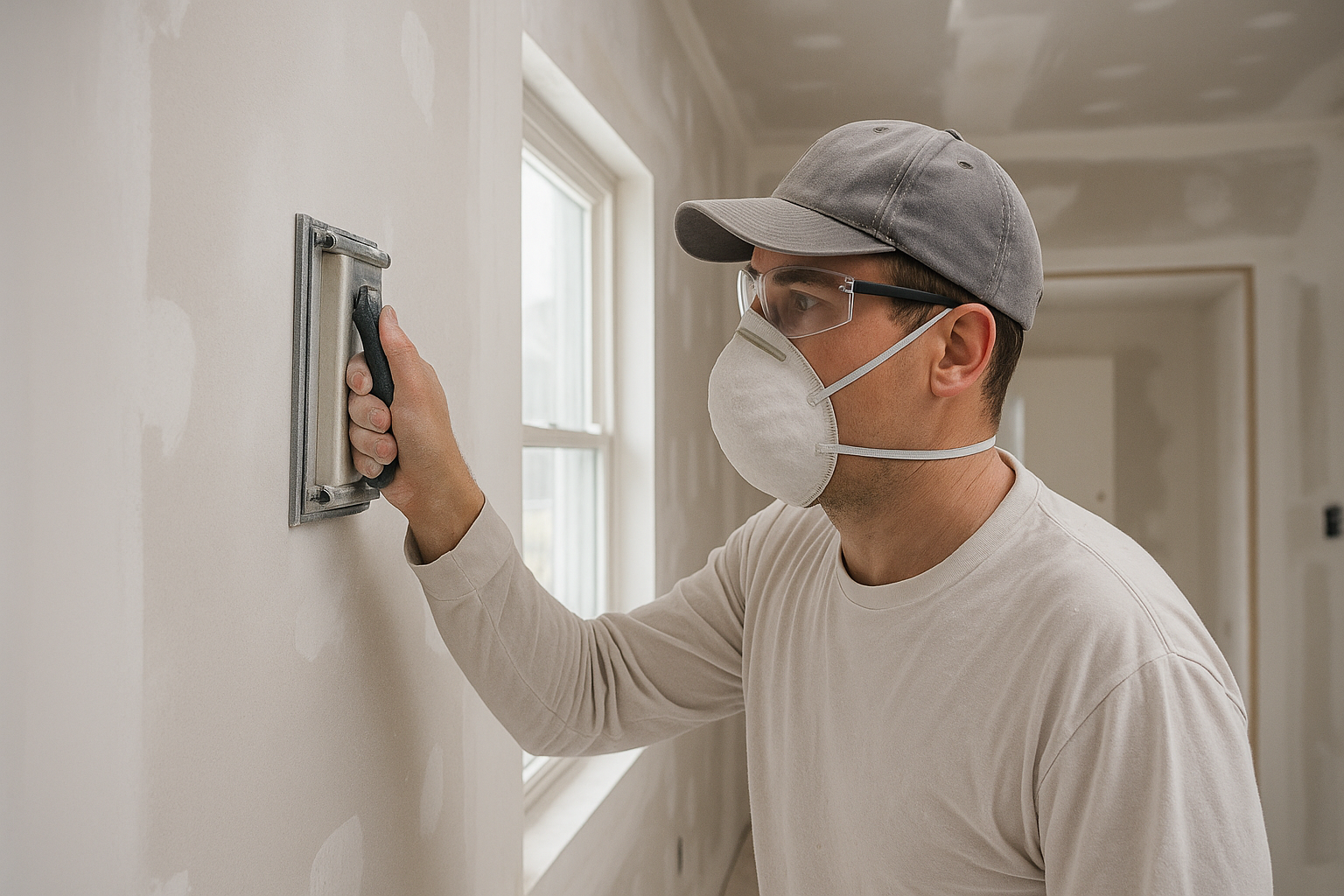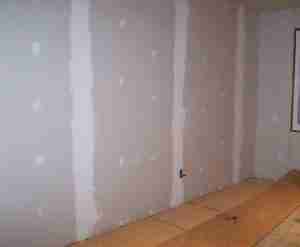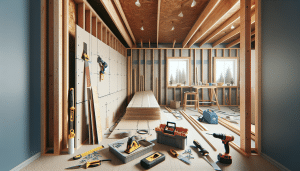There’s a reason most homeowners dread the Sanding phase of a renovation more than anything else. It’s messy, it’s tiring, and if you mess it up, you’ve essentially ruined all the hard work you put into Hanging and Taping those drywall sheets. You might think the hard part is over once the mud is on the wall, but honestly, the sanding stage is where the magic—or the disaster—happens.
Contents
- 1 Wait, Is That Mud Actually Dry?
- 2 Stop Using the Wrong Grit (You Aren’t Sanding a Deck)
- 3 Ignoring the “Fuzz” Factor
- 4 Sanding in the Dark (Or Just Bad Lighting)
- 5 Forgetting to Protect Your Lungs (and Your Furnace)
- 6 The “Just Paint It” Mentality
- 7 Not Considering Wet Sanding
- 8 Digression: Why Is It Always the Ceilings?
- 9 When to Throw in the Towel (and Call Us)
Wait, Is That Mud Actually Dry?
We need to talk about patience. It’s a virtue, sure, but in the world of drywall finishing, it’s a requirement. One of the absolute biggest mistakes we see folks making from Salt Lake County up to Davis County is trying to sand joint compound that isn’t 100% cured.
You know what happens when you take sandpaper to damp mud? It doesn’t smooth out. It balls up. It clogs your sandpaper instantly, and worse, it tears chunks out of the work you just spent hours smoothing with your trowel. It’s heartbreaking.
Living here along the Wasatch Front, we actually have it pretty good. Our high desert climate usually sucks the moisture right out of joint compound, helping it dry faster than it would in a humid place like Florida. But don’t let that trick you. Just because the surface looks white and chalky doesn’t mean the mud deep in the joint is dry. If the center is still gray, walk away. Go grab a soda, hike a trail, do whatever you need to do. Just don’t sand it.
Stop Using the Wrong Grit (You Aren’t Sanding a Deck)
Here is a trap a lot of DIYers fall into. You want the job done fast, right? So, logic tells you to grab the coarsest sandpaper you can find to rip through that excess mud quickly.
Please, for the sake of your walls, put down the 60-grit paper.
Using coarse grit on drywall is like trying to cut a tomato with a chainsaw. Sure, it’ll cut, but it’s going to leave a mess. Drywall compound is soft. It yields easily. If you use anything lower than 120-grit, you are going to leave deep scratches that paint will not hide. In fact, paint tends to highlight scratches, making them look like little canyons on your wall once the light hits them.
Here’s a quick rule of thumb for grit selection:
| Grit Level | Best Use Case | Result |
|---|---|---|
| 60-80 Grit | Removing rough textures or old paint (Rarely for new mud) | heavy scratches, aggressive removal |
| 100-120 Grit | Initial sanding of rough ridges | Good removal, minor scratches |
| 150 Grit | The Gold Standard for general sanding | Smooth finish, minimal scratching |
| 220 Grit | Final polishing and touch-ups | Ultra-smooth, slow removal |
Stick to 150-grit for most of your work. It removes material efficiently but leaves a surface smooth enough for primer.
Ignoring the “Fuzz” Factor
Have you ever sanded a spot so much that the cardboard surface of the drywall started to get rough and hairy? That’s called scuffing the paper, and it is a nightmare to fix.
This usually happens when people are trying to sand out a depression or a low spot. They keep grinding away at the surrounding area to make it level, and suddenly—bam—they’ve sanded right through the compound and into the paper facing of the drywall sheet.
Once that paper fuzzes up, you can’t just paint over it. The texture will show through forever. If you do this (and hey, accidents happen), you have to seal that paper with a specialized primer or a skim coat of mud to mat those fibers down before you can try again. The best way to avoid this? Don’t try to sand out low spots. Fill them. Add more mud, let it dry, and sand again. It’s always better to build up than to dig down.
Sanding in the Dark (Or Just Bad Lighting)
You might think the overhead lights in your room are enough. They aren’t.
When you look at a wall straight on with ambient lighting, it might look smooth as glass. But the second you open the blinds on a sunny Utah morning, or turn on a lamp that casts a shadow across the wall, every ripple, bump, and ridge is going to pop out.
Professional tapers use what we call a rake light. It sounds technical, but it’s literally just a trouble light or a strong flashlight held against the wall at a sharp angle. The severe angle casts long shadows from even the tiniest imperfections.
It can be a little depressing, honestly. You think you did a perfect job, then you shine the light and it looks like a relief map of the Rocky Mountains. But wouldn’t you rather see that before you paint? Use a handheld light, check your work constantly, and circle the problem areas with a pencil so you know where to focus.
Forgetting to Protect Your Lungs (and Your Furnace)
Drywall dust is insidious. It’s essentially a fine powder of gypsum and silica. It hangs in the air, drifts into other rooms, and worst of all, gets sucked into your HVAC returns.
I’ve seen homeowners finish a Basement project in Sandy, only to realize two weeks later that their brand new furnace is wheezing because the filter is caked in half an inch of white powder.
Before you start sanding:
- Cover your vents: Tape plastic over the intake and output vents in the room.
- Wear a mask: Not just a shirt pulled over your nose. Use an N95 respirator. Your lungs will thank you later.
- Create a barrier: Hang plastic sheeting in doorways to keep the dust contained to the work zone.
If you want to get fancy, you can use a dustless sanding system—essentially a pole sander attached to a Shop-Vac. It doesn’t catch 100% of the dust, but it catches about 90%, which makes cleanup a breeze.
The “Just Paint It” Mentality
This is perhaps the most tempting mistake of all. You’ve been sanding for hours. Your arms hurt. You’re covered in white dust. You look at a scratch or a ridge and think, “Eh, the paint will cover that.”
Let me be the bearer of bad news: Paint is not a filler.
Standard latex paint forms a thin film. It contours to whatever is underneath it. If there is a scratch, the paint will sink into the scratch. If there is a lump, the paint will go over the lump. High-gloss or semi-gloss paints (often used in kitchens and bathrooms) are even less forgiving. They reflect light, which acts like a spotlight on bad sanding jobs.
If you aren’t happy with how the wall looks raw, you won’t be happy with how it looks painted. Take the extra twenty minutes to touch up that spot.
Not Considering Wet Sanding
Did you know you don’t always have to use sandpaper? For small repairs or really delicate areas, like corners where you don’t want to scuff the adjacent wall, wet sanding is a fantastic trick.
You use a coarse sponge—specifically a drywall sponge, though a barely-damp kitchen sponge can work in a pinch for tiny spots—to rub the compound. The water reactivates the outer layer of the mud, allowing you to wipe away high spots and smooth out ridges without creating any dust.
Now, you can’t wet sand a whole house. It’s too slow, and it doesn’t get things quite as flat as paper does. But for fixing a corner in a finished bedroom without covering the furniture in dust? It’s a lifesaver.
Digression: Why Is It Always the Ceilings?
Speaking of things that are hard to sand—ceilings. Why do we punish ourselves with smooth ceilings? I mean, I know why; it looks modern and clean. But standing on a ladder, looking up, with dust falling directly into your eyes (wear goggles, folks), is a special kind of torture.
If you are sanding a Ceiling, gravity is your enemy. The weight of the pole sander makes it easy to apply too much pressure on one side, gouging the mud. Make sure you are using a pole with a pivoting head that flips easily so it stays flat against the ceiling surface. And take breaks. Once your arms get tired, your technique gets sloppy, and that’s when mistakes happen.
When to Throw in the Towel (and Call Us)
Look, we love the DIY spirit. There is something satisfying about fixing up your own home. But drywall finishing is truly an art form. It takes years to develop the muscle memory to feather an edge perfectly or spot a flaw before it’s painted.
If you find yourself staring at a wall that looks like a choppy sea, or if the dust is just becoming too much to handle, there is no shame in calling in the cavalry. Whether you are in Utah County, Salt Lake, or up in Davis, sometimes the best tool for the job is a phone.
We can come in, assess the situation, and get those walls looking smooth as glass in a fraction of the time it might take you to do it yourself. Plus, we bring our own vacuums.
Ready to skip the dust and get straight to the beautiful walls?




